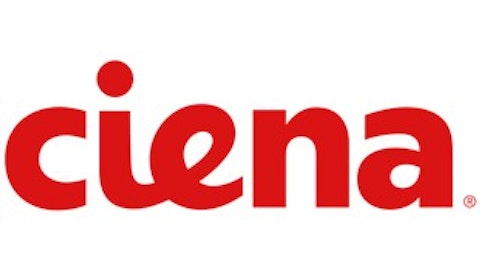The networking equipment industry has been a tough one to navigate this past year. Investors who have been following this market should have noticed several major trends by now – a heavy dependence on government, telecom and enterprise spending, a brutal pricing war, and a revelation that in tough times, leaner businesses fare better. It’s often difficult for these companies, which offer a wide variety of products, such as switches, routers, wireless LAN equipment, application delivery controllers and network security equipment, to outmaneuver each other, since relative size and pricing power can easily allow larger companies such as Cisco Systems, Inc. (NASDAQ:CSCO) to crush the competition.
In this article, I’ll examine three names in the networking field – Aruba Networks, Inc. (NASDAQ:ARUN), Palo Alto Networks Inc (NYSE:PANW) and Ciena Corporation (NASDAQ:CIEN) – which respectively represent weak, mixed and strong players in this cutthroat industry.
Aruba Networks, Inc. (NASDAQ:ARUN)
Aruba Networks, Inc. (NASDAQ:ARUN) Networks’ primary business is wireless LAN (WLAN) equipment focused on the enterprise market. It specializes in wireless access points, mobility controllers and network management software. The Sunnyvale, Calif.-based company is currently the second largest WLAN equipment manufacturer in the world, with a 10.6% market share in 2012, which only trails Cisco Systems, Inc. (NASDAQ:CSCO)’s 50.7%. Over the past five years, Aruba Networks, Inc. (NASDAQ:ARUN)’s top and bottom lines have risen 58.6% and 75.7%, respectively, fueled by strong demand for increased wireless connections in the workplace.
That growth, however, came to a grinding halt after the company reported disappointing third quarter earnings on May 16. Aruba Networks, Inc. (NASDAQ:ARUN) posted a net loss of $0.18 per share, or $20.2 million, an alarming decline from the profit of $0.05 per share, or $6.0 million, it reported in the prior year quarter. Adjusting for one-time charges, the company earned $0.11 per share, which still missed the consensus estimate by a penny. Revenue climbed 12% to $147.1 million, topping analyst forecasts.
The primary reason for this disconnect between Aruba’s top and bottom-line growth was its loss of pricing power. During the quarter, Cisco started bundling WLAN products together with its routers and data centers at steep discounts, sacrificing margins with the goal of capturing more market share from Aruba, Hewlett-Packard Company (NYSE:HPQ) and Ruckus Wireless Inc (NYSE:RKUS). As a result, the government, telecom and enterprise sectors which Aruba heavily relies on flocked to Cisco instead, since Cisco could bundle WLAN equipment with other networking products that Aruba was unable to offer.
Last quarter, Cisco reported 5.4% and 14.5% increase in its top and bottom lines, respectively, indicating that not only is the company’s pricing strategy working, but it also hasn’t hurt its profitability. For now, it seems like Aruba has given up on fighting Cisco, and provided weak guidance for the fourth quarter that missed analyst estimates by a wide margin.
Palo Alto Networks Inc (NYSE:PANW)
Another recent loser in the networking industry is Palo Alto Networks Inc (NYSE:PANW), which specializes in high-level network security systems. Although the Santa Barbara, Calif.-based company only went public last July, it has been around since 2005, and grown on robust enterprise demand for strong protection from increasingly dangerous hacking attacks. The business model appeared to have high growth potential, since its core business of firewalls was a much higher-margin business than traditional network equipment, such as routers, switches or WLAN equipment. For a while, investors agreed, bidding shares up 69% from its IPO price of $42 to $71 by last September.






